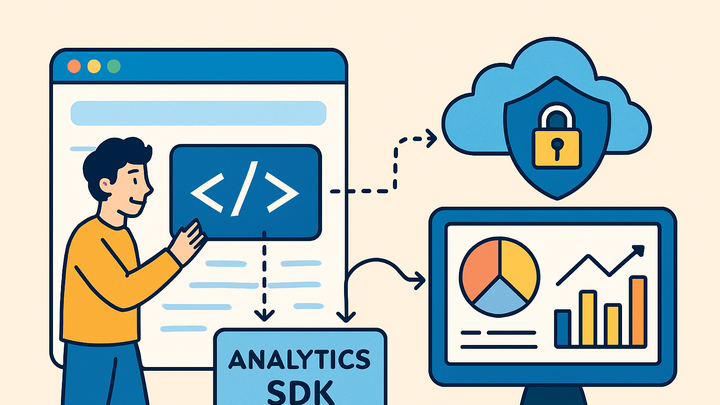Published on 2025-06-28T09:12:18Z
What Is an Analytics SDK? Examples from PlainSignal & GA4
An Analytics SDK (Software Development Kit) is a library or set of tools that developers integrate into web or mobile applications to collect, process, and send usage data to an analytics backend. It abstracts away the low-level details of event capture, device compatibility, batching, and network requests. By using an SDK, teams can track user interactions (clicks, page views, form submissions), measure performance metrics (load times, errors), and capture custom events without manually building each component.
Examples of popular Analytics SDKs include Google Analytics 4 (GA4) and PlainSignal, a cookie-free, GDPR-friendly analytics solution.
Key Features
- Event instrumentation APIs (
trackEvent,pageView) - Offline storage and batching
- User identification and session management
- Data encryption and privacy controls
Integrating an Analytics SDK typically involves adding a small snippet of JavaScript (for web) or installing a package (for mobile) and initializing it with a unique project ID or API key.
Analytics sdk
A toolkit of libraries and tools that developers embed to collect and send user interaction and performance data from web or mobile apps.
Overview of Analytics SDK
This section explains the concept, components, and role of an Analytics SDK in modern applications.
-
Definition and purpose
An Analytics SDK provides pre-built functions and interfaces for capturing user events, managing sessions, and sending data to an analytics backend without low-level coding.
-
Web vs. mobile sdks
Web SDKs are JavaScript libraries for browsers; Mobile SDKs are native libraries for iOS/Android, offering platform-specific optimizations.
-
Core components
Typically includes an event-tracking API, batching mechanism, network layer, and configuration module.
-
-
Key benefits
Using an SDK accelerates development, ensures consistent data collection, and handles edge cases like offline mode and retry logic.
-
Consistency
Standardizes event naming and payload formats across platforms.
-
Implementation Examples
Code examples showing how to integrate popular Analytics SDKs on a website.
-
PlainSignal cookie-free analytics
Integrate PlainSignal by adding their async script tag and initializing with your domain and project ID.
-
Code snippet
<link rel="preconnect" href="//eu.plainsignal.com/" crossorigin /> <script defer data-do="yourwebsitedomain.com" data-id="0GQV1xmtzQQ" data-api="//eu.plainsignal.com" src="//cdn.plainsignal.com/plainsignal-min.js"></script>
-
-
Google analytics 4 (GA4)
Use the gtag.js library provided by Google to configure and send events.
-
Code snippet
<script async src="https://www.googletagmanager.com/gtag/js?id=G-XXXXXXXXXX"></script> <script> window.dataLayer = window.dataLayer || []; function gtag(){dataLayer.push(arguments);} gtag('js', new Date()); gtag('config', 'G-XXXXXXXXXX'); </script>
-
Best Practices
Guidelines to ensure reliable, privacy-compliant, and performant implementation.
-
Version management
Keep your SDK updated to benefit from new features, bug fixes, and security patches.
-
Privacy and consent
Implement user consent flows and honor opt-out preferences, especially when using cookie-based SDKs.
-
Performance optimization
Load SDKs asynchronously, minimize blocking, and use sampling or batching to reduce network overhead.
Challenges and Considerations
Common pitfalls and things to monitor when working with Analytics SDKs.
-
Data accuracy
Network failures, ad blockers, or incorrect initialization can lead to missing or duplicate events.
-
Cross-platform consistency
Ensure event definitions and user identifiers are consistent across web, iOS, and Android implementations.
